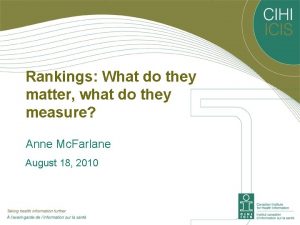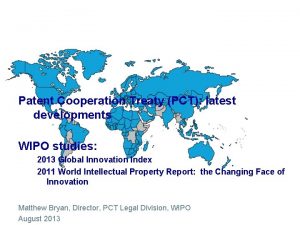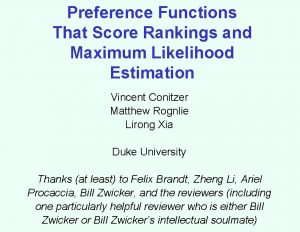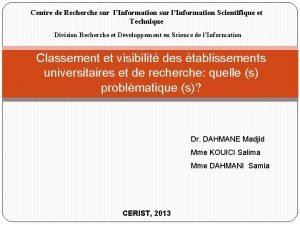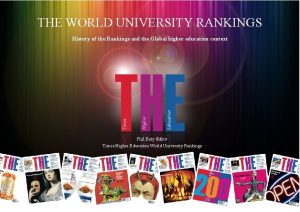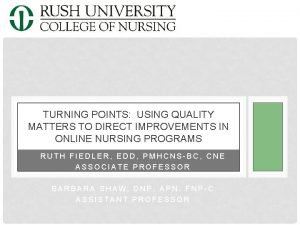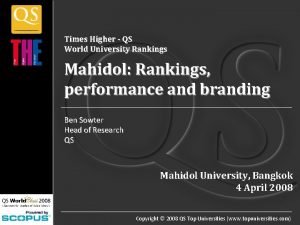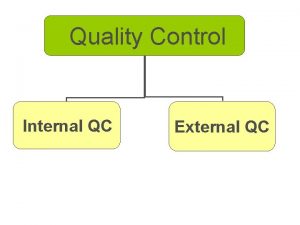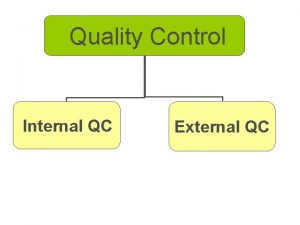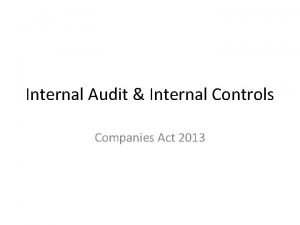Using Rankings to Drive Internal Quality Improvements The
























- Slides: 24

Using Rankings to Drive Internal Quality Improvements: The Asian Experience Dr. Kevin Downing Director of Knowledge, Enterprise and Analysis City University of Hong Kong

Session Flow 1 Rising Asia-Rising Africa? 2 2 Dominant Global Ranking Systems 3 3 Benefits of Rankings 4 4 Conclusion

Ranking Systems - Criteria and Weighting Academic Ranking of World Universities (ARWU) Nobel/ Per Capita Fields Medal Performanc e 10% Alumni, 10% SCI/SSCI/ A& HCI Articles, 20% Nobel/ Fields Medal Winner, 20% QS World University Rankings (QS-WUR) Citations Per Faculty, 20% Int'l Student, 5% Academic Peer Review, 40% Int'l Faculty, 5% Nature/ Science Articles, 20% Hi. Ci Researcher, 20% Student Faculty Ratio, 20% Times Higher Education of World University Ranking (THE) Research volume, income and reputation, 30% Research Income from Industry, 2. 5% Employer Review, 10% Int'l Staff and Student, 5% Teaching & learning environment, 30% Citations, Per Paper, 32. 5%

QS-WUR vs. ARWU (Top 200) Concordance Analysis – Kendall’s W (2007 -2010) 1. 2 QS ARWU 1 0. 94 0. 99 0. 94 0. 87 0. 75 0. 6 0. 8 0. 72 0. 64 0. 2 0 Top 51 -100 Top 101 -150 Top 151 -200

QS-WUR vs. ARWU (Asian Universities in Top 300) Concordance Analysis – Kendall’s W (2007 -2010) QS ARWU 1. 2 1 0. 94 0. 8 0. 95 0. 89 0. 74 0. 69 0. 74 0. 2 0 Top 101 to 200 Top 201 to 300

QS-WUR vs. ARWU (Top 200) Mean Standard Deviation of Ranks (Over the Past 4 Years)

Number of Asian Universities in QS World University Rankings (2007 – 2010)

Asian Universities in QS-WUR Top 200 (By Country, 2007 – 2010)

Asian Universities vs. American Universities Mean Rank Comparison (QS-WUR, 2007 to 2010) Asian Universities

Hong Kong Institutions in QS World University Rankings (Top 400) in 2010

Comparative Analysis of Universities in Hong Kong (2010)

What’s the use of rankings? Global Market Demand • International study trends show that world wide demand for education is on the rise. Higher Education is becoming more global and competitive. Global Market Shaping • University rankings shape the global market in higher education as much as (or more than) they describe it. By changing the rankings we alter global competition. Global Market Value • Knowledge is the key driver of international competitiveness. Ranking will raise global awareness of those institutions and universities being ranked.

Benefits of Rankings Reputation and Visibility Research and Academic Development Globalisation Strategic Planning

Reputation and Visibility • Website Local Reputation • Press releases • Overcome bias and • Enhance global traditional consensus visibility and of reputation. awareness. • Establish institutional • Official presentations Publicity • International conferences/meetings Global Reputation brand.

Globalisation Economic Globalisation • Global rankings are powerful weapon in the battle for talent. • Propagate cross-border relationships and continuous global flows of people, information knowledge, technologies, products, and financial • Attract quality foreign students and faculty members to Cultural Globalisation enhance campus diversity and students’ international perspective. capital.

Research and Academic Development • Attract international partners to undertake high impact Academic Development research of potential academic or commercial values. • Opportunities to expand academic partnerships with world-leading institutions. • Extend the quality, breadth, and impact of academic programmes. • International collaboration help cultivate multicultural Research perspectives. Development of faculty and encourage engagement with global issues.

Strategic Planning • Data-driven decision making based on institutional performance indicators. Benchmarking • Benchmark against ‘best practice’ to enhance global • Ranking criteria can help focus on core areas of Internal practice, strategy can be Evaluation aligned with indicators to improve quality. competitiveness.

Using Rankings to Improve Institutional Quality Identify Core Focus Areas • Ranking criteria help an institution focus on core areas of practice and encourage an evidence-based approach to quality improvement. Strategic Planning • Data driven decision making based on institutional performance indicators. Strategy can then be aligned with indicators to improve quality. Funding Lobbying • Rankings can be used to lobby government and funding bodies.

What’s the use of rankings? Examples from City University of Hong Kong Use ranking criteria to identify appropriate benchmarks in line with institutional aspirations. Benchmark against ‘best practice’ and learn from peer institutions. External Benchmarking College/School Level Departmental Level Annual assessment based on quantitative performance indicators for learning and teaching, research, and knowledge transfer. Establish panel of management and external experts to consider anomalous data or representations from departments. Strategy can then be developed to address issues of accountability and improve quality.

Performance Indicators % International Students Average Entry A-Level Score Input Quality Index % Self-financed Students Average Entry English Score % Faculty to Total Academic Staff % Faculty with Ph. D or Professional Accreditation Staffing and Resources Index Number of Students Per Faculty % International Faculty % Outbound Exchange Students % Graduates with FT Employment (within 6 months of completion) Output Quality Index % Student with Internship Experience

Staircase Model Threshold (One star) Input Quality Index Staffing and Resources Index Output Quality Index Towards Excellence (Two star) Excellence (Three star)

Example Growth Chart (Department X)

Example Growth Chart (Department Y)

Conclusion Time to Choose your Focus! • The notion of a ‘World Class University’ is becoming ever more important to governments, employers, investors, alumni, students and applicants. • Rankings provide some comparative measures of an institutions global standing and it is a catalyst for further healthy competition. • Try to identify which rankings might be used to bring about practical positive strategic change which will benefit all stakeholders, not least the ultimate product of our endeavours, the quality of our graduates and our research output. • Whilst rankings are necessarily imperfect and will always inspire debate, they are also currently inspiring and creating the opportunity for many Asian institutions to emerge from the long shadows cast by those in the West.
 Https drive google com drive u 1 shared with me
Https drive google com drive u 1 shared with me Https://slidetodoc.com
Https://slidetodoc.com Google classroom
Google classroom Unit 25 special refrigeration system components
Unit 25 special refrigeration system components Ut arlington rankings
Ut arlington rankings Rankings: what are they and do they matter?
Rankings: what are they and do they matter? Gii rankings
Gii rankings Mpumalanga junior golf
Mpumalanga junior golf Mpumalanga junior golf
Mpumalanga junior golf Mle rankings
Mle rankings Hulbert financial digest rankings
Hulbert financial digest rankings The world scientific literacy rankings
The world scientific literacy rankings Intracranial pressure monitoring
Intracranial pressure monitoring Scimago institutions rankings (sir)
Scimago institutions rankings (sir) World university rankings history
World university rankings history County health rankings indiana
County health rankings indiana Health rankings
Health rankings Improvements and betterments insurance
Improvements and betterments insurance Pughs tires
Pughs tires Www svcfin com make a payment
Www svcfin com make a payment Offsite improvements
Offsite improvements Improvements roadmap
Improvements roadmap Direct improvements
Direct improvements Medicare improvements for patients and providers act
Medicare improvements for patients and providers act Differentiate between belt drive and chain drive
Differentiate between belt drive and chain drive





